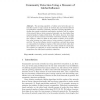Free Online Productivity Tools
i2Speak
i2Symbol
i2OCR
iTex2Img
iWeb2Print
iWeb2Shot
i2Type
iPdf2Split
iPdf2Merge
i2Bopomofo
i2Arabic
i2Style
i2Image
i2PDF
iLatex2Rtf
Sci2ools
108
click to vote
CORR
2008
Springer
2008
Springer
Community Detection using a Measure of Global Influence
Abstract. The growing popularity of online social networks gave researchers access to large amount of network data and renewed interest in methods for automatic community detection. Existing algorithms, including the popular modularity-optimization methods, look for regions of the network that are better connected internally, e.g., have higher than expected number of edges within them. We believe, however, that edges do not give the true measure of network connectivity. Instead, we argue that influence, which we define as the number of paths, of any length, that exist between two nodes, gives a better measure of network connectivity. We use the influence metric to partition a network into groups or communities by looking for regions of the network where nodes have more influence over each other than over nodes outside the community. We evaluate our approach on several networks and show that it often outperforms the edge-based modularity algorithm. Key words: community, social networks,...
Related Content
| Added | 09 Dec 2010 |
| Updated | 09 Dec 2010 |
| Type | Journal |
| Year | 2008 |
| Where | CORR |
| Authors | Rumi Ghosh, Kristina Lerman |
Comments (0)

